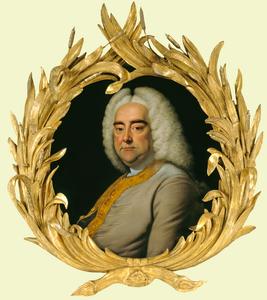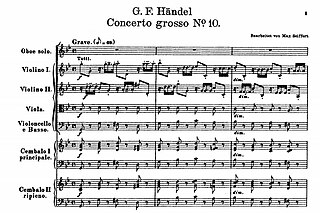Related Research Articles
This is a list of notable events in music that took place in the year 1735.
The year 1711 in music involved some significant events.
The Händel-Werke-Verzeichnis is the Catalogue of Handel's Works. It was published in three volumes by Bernd Baselt between 1978 and 1986, and lists every piece of music known to have been written by George Frideric Handel. The catalogue also includes the first few bars of each piece and large amounts of factual information including manuscript sources, early prints, photographs, spurious works, etc. The catalogue does not include the full scores of Handel's works.

Alexander's Feast is an ode with music by George Frideric Handel set to a libretto by Newburgh Hamilton. Hamilton adapted his libretto from John Dryden's ode Alexander's Feast, or the Power of Music (1697) which had been written to celebrate Saint Cecilia's Day. Jeremiah Clarke set the original ode to music.
As pants the hart is an anthem composed by George Frideric Handel for the Chapel Royal of Queen Anne and subsequently revised. There are five versions of the work, the first being completed in 1713, and the final in 1738. HWV 251a was the first anthem Handel composed for the Chapel Royal.
Fitzwilliam Sonatas is the name first given by Thurston Dart to an arrangement he made, based on two recorder sonatas by George Frideric Handel, which he recast as a group of three sonatas. The term was applied by later editors to the original two sonatas as Handel wrote them, and was also expanded to encompass several other sonatas for various instruments included in the Handel autograph manuscripts held by the Fitzwilliam Museum in Cambridge.

Ero e Leandro, also known after its first line as Qual ti reveggio, oh Dio, is a 1707 Italian-language cantata by George Frideric Handel, composed during his stay in Rome to a libretto believed to be written by Cardinal Pietro Ottoboni. It is a reworking of the Greek myth of Hero and Leander, with the soprano soloist taking the role of Hero. In it, Hero finds her love, Leander, drowned, tears out her hair, thus symbolically rejecting the beauty which had led to Leander's fascination with her, then drowns herself. It is composed for a soprano solo, and a small orchestra consisting of two oboes, and two string sections: a concertino of solo violin and violoncello, and a concerto grosso made up of two violins, a viola, and continuo. In Ero e Leandro, Recitatives alternate with arias, as was normal at the period for not only cantatas, but oratorios and operas as well; however, unusually, Ero e Leandro ends with a recitative, instead of an aria.

The Handel organ concertos, Op. 4, HWV 289–294, are six organ concertos for chamber organ and orchestra composed by George Frideric Handel in London between 1735 and 1736 and published in 1738 by the printing company of John Walsh. Written as interludes in performances of oratorios in Covent Garden, they were the first works of their kind for this combination of instruments and served as a model for later composers.

The Handel organ concertos, Op. 7, HWV 306–311, refer to the six organ concertos for organ and orchestra composed by George Frideric Handel in London between 1740 and 1751, published posthumously in 1761 by the printing company of John Walsh. They were written for performance during Handel's oratorios, contain almost entirely original material, including some of his most popular and inspired movements.
A fine and delicate touch, a volant finger, and a ready delivery of passages the most difficult, are the praise of inferior artists: they were not noticed in Handel, whose excellencies were of a far superior kind; and his amazing command of the instrument, the fullness of his harmony, the grandeur and dignity of his style, the copiousness of his imagination, and the fertility of his invention were qualities that absorbed every inferior attainment. When he gave a concerto, his method in general was to introduce it with a voluntary movement on the diapasons, which stole on the ear in a slow and solemn progression; the harmony close wrought, and as full as could possibly be expressed; the passages concatenated with stupendous art, the whole at the same time being perfectly intelligible, and carrying the appearance of great simplicity. This kind of prelude was succeeded by the concerto itself, which he executed with a degree of spirit and firmness that no one ever pretended to equal.
The Flute sonata in G major was composed by George Frideric Handel in F major for the oboe, and was transposed by an unknown hand to G major, for flute and basso continuo. The work is also referred to as Opus 1 No. 5, as it was first published in 1726 or slightly later by the London publisher Walsh, in an edition falsely attributed to Jeanne Roger of Amsterdam. Other catalogues of Handel's music have referred to the work as HG xxvii, 19; and HHA iv/3,28. The sonata was originally composed as an oboe sonata in F major.
The Oboe sonata in F major was composed by George Frideric Handel, for oboe and basso continuo. The work is also referred to as HHA iv/18,36.
The Flute sonata in E minor is thought to have been composed by George Frideric Handel, for flute and basso continuo. The date of composition of the work is unknown, but it was first published in 1730. Other catalogues of Handel's music have referred to the work as HG xlviii, 134; and HHA iv/3,63.
The Oboe sonata in C minor was composed by George Frideric Handel for oboe and basso continuo. The work is also referred to as Opus 1 No. 8, and was first published in 1732 by Walsh. Other catalogues of Handel's music have referred to the work as HG xxvii, 29; and HHA iv/18,32.

The Oboe Concerto No. 3 in G minor was composed by George Frideric Handel for oboe, orchestra and basso continuo, possibly in 1704-1705, when he was still in Hamburg. It was first published in Leipzig in 1863 in which it was described as a work from 1703. No other source for the work is known. Other catalogues of Handel's music have referred to the work as HG xxi, 100; and HHA iv/12,3.
The Oboe Concerto No. 2 in B flat major was composed by George Frideric Handel for oboe, orchestra and basso continuo. It was first published in the fourth volume of Select Harmony by Walsh in 1740. Other catalogues of Handel's music have referred to the work as HG xxi, 91; and HHA iv/12,47.
The Sonata in F major was composed by George Frideric Handel for recorder and basso continuo. The work is also referred to as Opus 1 No. 11, and was first published in 1732 by Walsh. Other catalogues of Handel's music have referred to the work as HG xxvii, 40; and HHA iv/3,52.
The Violin sonata in G minor was composed by George Frideric Handel for violin and basso continuo. The work is also referred to as Opus 1 No. 6, and was first published in 1732 by Walsh. Other catalogues of Handel's music have referred to the work as HG xxvii,22; and HHA iv/18,6. Also published in HG xlviii,118.

The Concerti grossi, Op. 3, HWV 312–317, are six concerti grossi by George Frideric Handel compiled into a set and published by John Walsh in 1734. Musicologists now agree that Handel had no initial knowledge of the publishing. Instead, Walsh, seeking to take advantage of the commercial success of Corelli's Concerti grossi, Op. 6, simply combined several of Handel's already existing works and grouped them into six "concertos".
The Concerto Grosso 1985 is a composition for chamber orchestra by the American composer Ellen Taaffe Zwilich. The work was commissioned by the Washington Friends of Handel in commemoration of the 300th anniversary of the birth of George Frideric Handel. It was given its world premiere by Handel Festival Orchestra conducted by Stephen Simon on May 9, 1986.
References
- 1 2 3 Hicks, Anthony (2001). "Handel, George Frideric". In Sadie, Stanley; Tyrrell, John (eds.). The New Grove Dictionary of Music and Musicians . Vol. x (2nd ed.). London: Macmillan. p. 797.
- ↑ The Musical Times , David Humphreys: 'HWV301', vol.151 no.1913 (Winter 2010), pp.2–3.